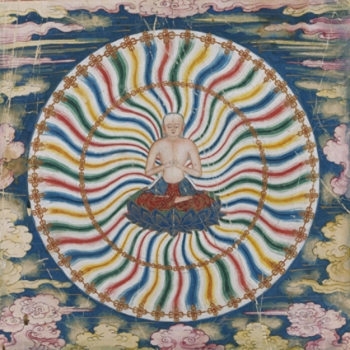In 1920, a Belgian missionary posted in Inner Mongolia received a mysterious gift from a Mongolian Tibetan-Buddhist monk: 54 painted pages illustrating various Buddhas, bodhisattvas, yoga positions, colored lights, fanciful animals, and mantras, as well as flamboyant scenery. Fascinating though these fantastic images were, the missionary had no idea what he had been given; the images came with no accompanying text or story about their origin. In due course, the album leaves were passed to the Ethnographic Museum in Belgium.
When they finally saw the images, a panel of Tibetan and Western experts realized they had come upon something unusual and exciting. Eventually, they determined that the paintings were a step-by-step guide to the visualization of the Buddha Vairochana, a tantric Buddha associated with kingship and Vajrayana/Tibetan Buddhism.
“The All-Knowing Buddha: A Secret Guide,” one of the latest exhibitions at the Rubin Museum of Art in New York City, features the 54 existing pages of this album along with rich supplementary material depicting Vairochana in many forms from many places, which illustrates how far this idea had spread. On one floor alone, one can see influences and artwork from places as diverse as Pakistan, Central Tibet, imperial China, Mongolia, and even Persia. This is the first time that all the images have been displayed together in America.
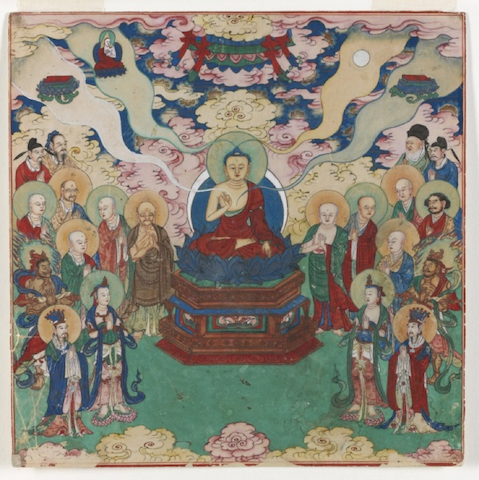
Many of the images in the set show the influence of these various cultures. This painting, depicting the moment of the historical Buddha Shakyamuni’s complete enlightenment, blends Chinese, Tibetan, Central Asian, and Indian symbols and ideas. The Buddha is drawn in a mixture of Chinese and Tibetan styles, while to his left and right are Confucian and Daoist monks and sages purely Chinese. Along the bottom left and right, Indian gods are dressed as Chinese kings. A Tibetan lama appears to the viewer’s upper left above the Buddha’s head. These intriguing images show just how widespread tantric Buddhism was, and how profoundly it influenced certain members of Chinese society.
For centuries, the esoteric, or hidden, tantric teachings of Vajrayana Buddhism, which involves complex visualizations and rituals, have been passed down in an unbroken lineage directly from teacher to student. Most of the time, the intricacies and deeper meaning of the practice being introduced were not written down or depicted in art. Everything was oral. A student had to receive his or her special instructions directly from the teacher. That is part of what makes this set of paintings unique.
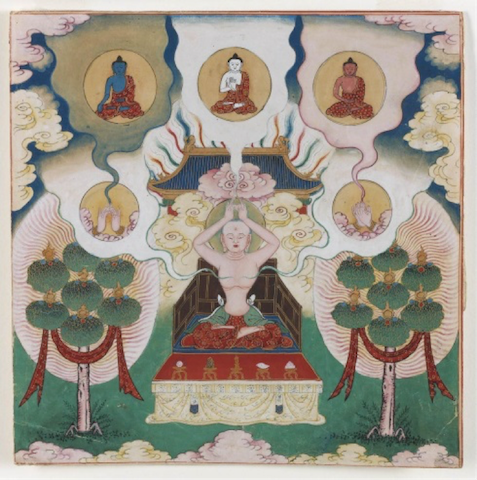

Some of these images illustrate hand gestures, or mudras, which involve the body as an enhancement of the mind’s visualization of specific Buddhas. While specific hand gestures are common in Himalayan art, hundreds more are only performed during rituals and were never illustrated in art from Tibet. This set of paintings gives instructions and diagrams for some of these specific mudras. In the image above, a practitioner is invoking white, red, and blue Buddhas, which represent the Buddhas’ body, speech, and mind. The mudras associated with this invocation are illustrated in circles to his left and right.
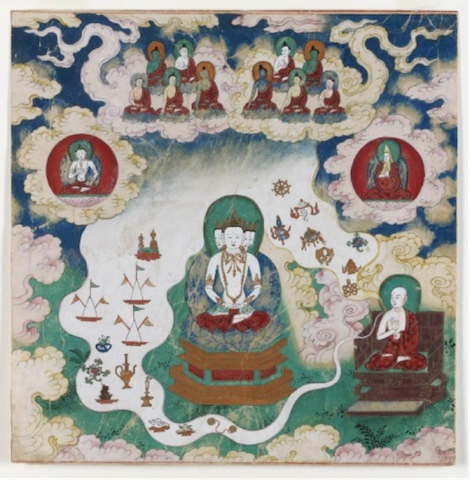
Other images, like the one above, illustrate the complex visualization practices a Vajrayana practitioner performs during meditation. In this image, the meditator (bottom right) is shown picturing the Buddha Vairochana in front of him (center). He also contemplates his own teacher above his head, a common devotional practice in this type Buddhism. From the meditator’s body, various substances emanate as offerings while other enlightened beings fill the sky, including Vajrasattva (center left), who purifies negative karma.
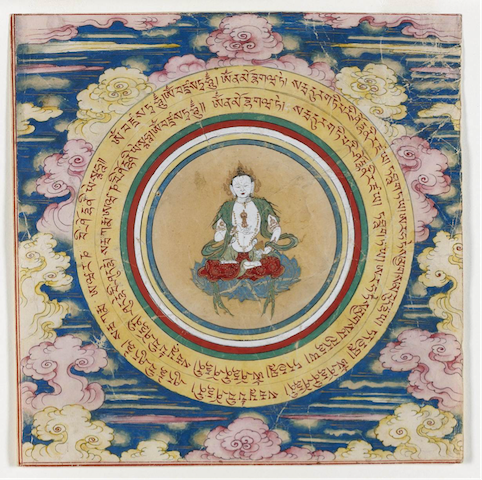
In other images, Vajrayana Buddhas and deities are shown alone. Here, Vajrasattva—in Tibetan, Dorje Sempa—is seated on a blue lotus. His body is white, and he holds a vajra in his right hand and a bell in his left. The vajra and bell symbolize wisdom, compassion, and the skillful means required to use these perfectly for the benefit all beings. Vajrasattva is also encircled by mantras. Although they were most likely painted by Chinese artists, the mantras are written in Tibetan script. After every recitation of a Dharma text, a practitioner recites the Vajrasattva mantra in order to purify any mispronunciation of words. As such, Vajrasattva practice is an essential element of Tibetan Buddhist ritual. In addition to its application in personal practice, the Vajrasattva mantra is regarded as having the ability to purify many aeons of karmic obscurations, to bring peace, and to engender enlightened activity in general.

In other images, Vajrayana Buddhas and deities are shown alone. Here, Vajrasattva—in Tibetan, Dorje Sempa—is seated on a blue lotus. His body is white, and he holds a vajra in his right hand and a bell in his left. The vajra and bell symbolize wisdom, compassion, and the skillful means required to use these perfectly for the benefit all beings. Vajrasattva is also encircled by mantras. Although they were most likely painted by Chinese artists, the mantras are written in Tibetan script. After every recitation of a Dharma text, a practitioner recites the Vajrasattva mantra in order to purify any mispronunciation of words. As such, Vajrasattva practice is an essential element of Tibetan Buddhist ritual. In addition to its application in personal practice, the Vajrasattva mantra is regarded as having the ability to purify many aeons of karmic obscurations, to bring peace, and to engender enlightened activity in general.
Taken together, these images paint a compelling picture of what the state of enlightenment might actually look like, and how the activities of an enlightened being are performed. Although their true order and complete purpose remain mysterious, and will until the original text upon which they were based is found, one can catch a glimpse of the rich world they represent. One can also contemplate that at a certain time, this type of esoteric practice and symbols was known not just to Tibetans, but served as a common language for many people across Asia.
Though their true purpose and creators remain obscured, one can imagine that whoever commissioned these works felt a similar sense of awe and fascination as the viewer when confronted with such magnificent imagery that encodes the highest truths. “The All-Knowing Buddha: A Secret Guide” will be on display at the Rubin Museum through 13 April 2015.
Tashi Chodron is coordinator of adult and academic outreach programs at the Rubin Museum of Art, and a lifetime practitioner of Tibetan Buddhism under the guidance of HH Penor Rinpoche. Harry Einhorn is a museum educator and performing artist in New York City; he is a student of Tibetan language and a second-generation American Buddhist, and has received teachings and instructions from many Kagyu and Nyingma lamas.
“The All-Knowing Buddha: A Secret Guide” is curated by Elena Pakhoutova and Karl Debreczeny. All of the images illustrated in this article are from the album.
For further information, see:
